Garden Maintenance Tips + Printable Schedule
If you have a yard with a lawn, landscaping, vegetable gardens, and flower gardens, there is always some garden maintenance to be done almost year-round. Granted, some seasons and months are busier than others, but it seems there is always something you could or should do to prepare for the next season.
Everything that slows us down and forces patience, everything that sets us back into the slow circles of nature, is a help. Gardening is an instrument of grace.
May Sarton
This post is a little refresher on essential garden maintenance for daily, weekly, monthly, and seasonal upkeep. These tips are available as a printable, in addition to the very helpful Pruning & Fertilizing Log to help you remember each plant’s fertilization and pruning needs.
In this post, I’ll provide gardening care tips to help you attain your goal of taking your garden to the next level. Continue reading to learn what you should do daily, weekly, monthly, and seasonally to keep your fruits and veggies growing and your vibrant flowers blooming! And make sure you nab the printables at the end of the post.
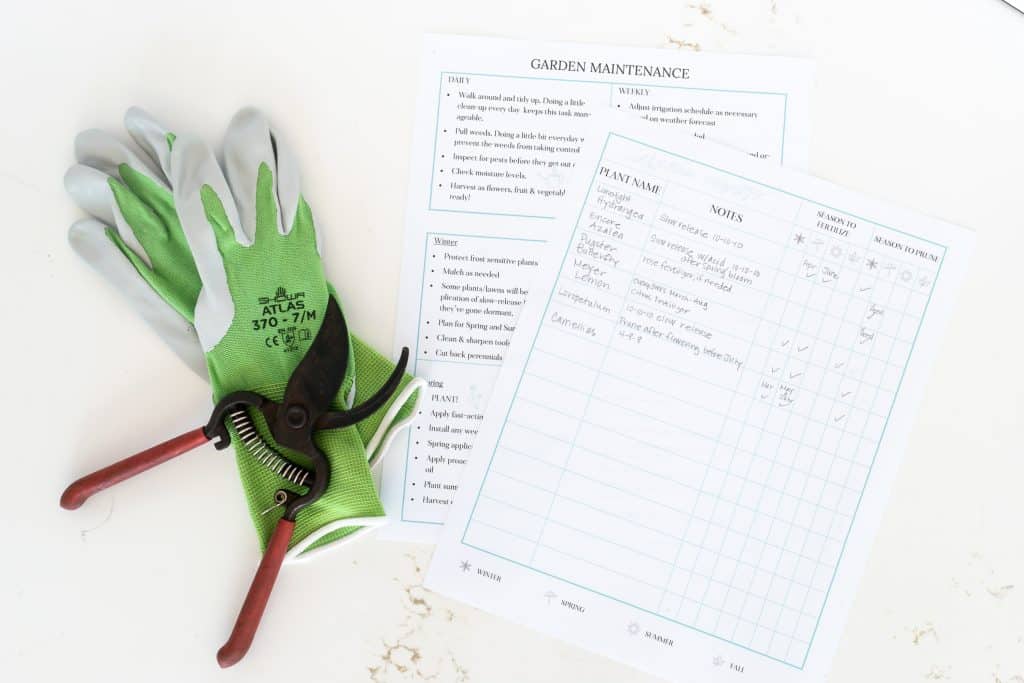
Table of Contents
Some of these links may be Amazon affiliate links and I may earn a small commission from the sale of these products to help defray the costs of operating this site, but the price you are charged is not affected. You can see my full disclosure policy here.
daily garden maintenance
General day-to-day tasks keep your garden healthy and thriving! There is no better adage than that uttered by Ben Franklin over 250 years ago when it comes to daily garden maintenance:
An ounce of prevention is worth a pound of cure.
Ben Franklin
Laying eyes on your garden frequently and pulling weeds while small can help prevent or minimize weed invasions, pest damage, and disease down the road.
tidy up
When you first walk out to your garden in the bright and welcoming morning air, look for anything you can tidy up. Part of your daily garden maintenance will include cleaning up fallen leaves, branches, and rotting fruits, veggies, or flowers.
Doing this daily will help prevent disease and pests in your garden. If you compost, you can add much of the collected debris to the pile. However, you’ll want to avoid including plants that have died from a disease in your compost pile. The disease may spread when you use the contaminated compost in your flourishing garden.
pull the weeds
Next, pull the weeds! These pesky plants steal nutrients and other resources from your garden. Plus, they can easily take over the space when you aren’t keeping up with them daily. You’ll want to look carefully—if you’re weeding the garden each day, the plants will likely be small and hidden among the ground covers, garden veggies, and flowers. I find a hand-held cultivator a handy tool when digging up weeds.
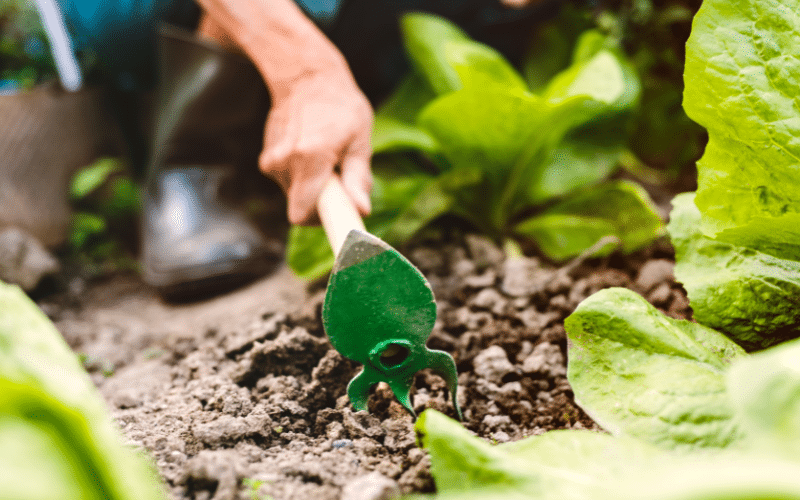
Once pulled, dispose of or dry the weeds in the sunlight. That way, you can toss them without worrying about them establishing in other areas of the yard. Another method of weed control is to suffocate them by covering them with mulch. This is an excellent long-term solution to dealing with weeds because the mulch helps to prevent weeds from sprouting in the first place.
Use my vinegar weed killer for tenacious weeds, hard-to-pull weeds, and weed-like plants (i.e., mint). I haven’t used a chemical weed killer for three years now, being perfectly satisfied with this vinegar/salt/soap recipe. But you can’t use just any vinegar…make sure to read the recipe.
inspect for pests
While searching the garden for weeds and debris, watch for signs of pests. Larger garden pests, like deer, bunnies, squirrels, moles, and mice, will often leave behind evidence, including:
- Chewed fruits and veggies
- Kicked-up soil
- Trampled plants
- Droppings
I’ve had pretty good luck with the Bobbex Deer Repellent, but it needs to be applied every 10 days to weeks for some of my ‘more attractive’ plants.
On the other hand, insects and other tiny pests will be more obvious to detect. In most cases, you will physically see the culprit, like aphids, cutworms, and beetles. Sometimes, you only see the damage they’ve caused, including tiny holes in leaves and gnawed-at stems.

To get rid of garden pests, you have a few options. First, you can directly pick them from the plant. This will ensure you eliminate all of them, and they will not spread to other plants. You can also spray the affected area with a homemade repellent, like a dish soap and water mixture or organic insecticidal soap.
Using nature to your advantage is the healthiest and most effective way to keep pests at bay. For instance, you can introduce other bugs that consume notoriously pesky garden insects. Ladybugs are a typical choice for those struggling with aphids. To keep the larger pests away, try planting the herbs and flowers that deter them. For instance, garlic makes a garden unwelcoming for rabbits and other small critters.
check the moisture levels
You may not need to water every day, but you should always check the moisture level in the soil. That way, you prevent over or under-watering your garden. Dip your fingers a couple of inches into the soil. Consider treating your precious plants with water if the ground feels very dry. In contrast, if the dirt is moist, you don’t have to worry about watering them until another day. Even if you already have a watering routine that seems to work, it’s wise to double-check your process.
harvest
Always keep up with harvesting, so your hard-earned vegetable, fruit, and flower bounty doesn’t go to waste. Of course, you won’t always have something to pick. You may even go weeks and months without a single thing to harvest. Nevertheless, it’s a garden maintenance task you should check in on daily—Just in case!
weekly garden maintenance
The bulk of your garden maintenance will include daily tasks. However, there are a few chores to complete every week. In addition to the following, weekly lawn maintenance is an excellent habit to form. That way, your entire yard is healthy and looks beautiful!
adjust the irrigation schedule
If you use a system like a drip irrigation, you’ll want to adjust the schedule according to the weekly forecast to avoid over or under-watering.
prune your plants
Once a week, when you have extra time to work in the garden, prune and deadhead your plants to help them thrive! You may also want to trellis any plants that need it. Not every week will require lots of pruning, deadheading, and trellising. It all depends on where your plants are in their growth stages and the weather.
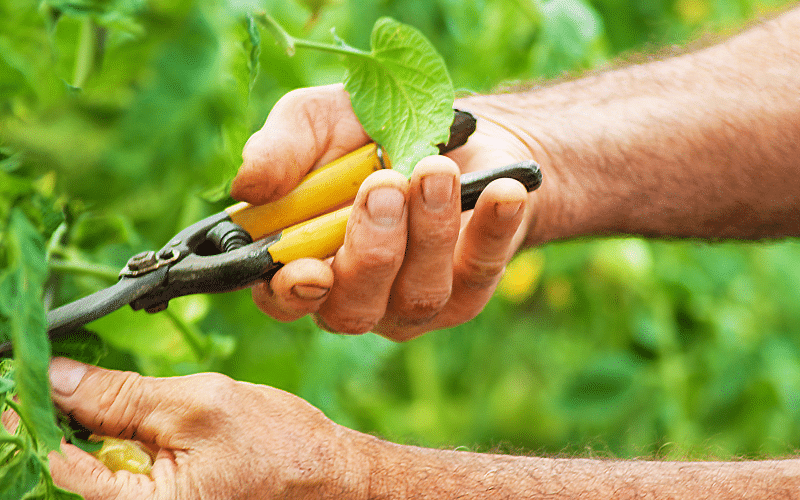
organize your gardening station
If you’re like most gardeners, tending to your plants isn’t your only responsibility. Life gets busy, and, in turn, your gardening station may get messy. If you aren’t great at cleaning up your tools and potting bench daily, choose one day out of the week to give your station the care it needs.
- Wipe the dirt off of any surfaces.
- Organize your tools.
- Hose off the patio.
- Wash the hand rags and towels you use while gardening.
- Adjust the setup to be more functional and efficient.
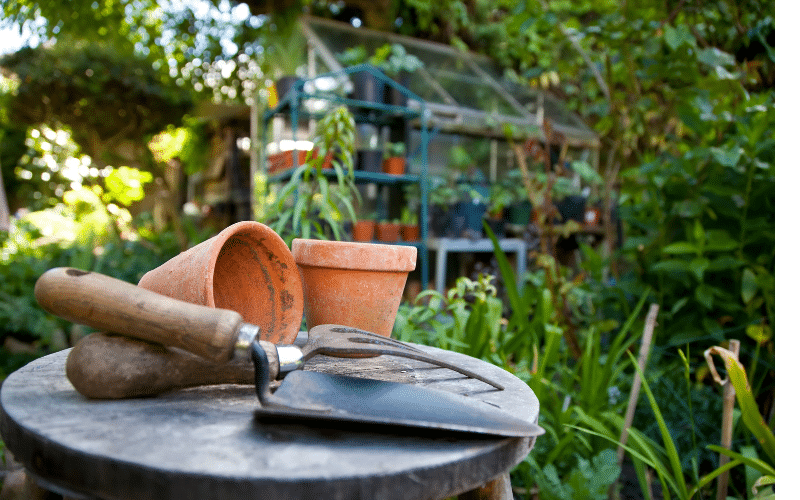
preventative pest control
Back to the wisdom of Ben Franklin, preventing pests is much preferable to having to handle them after the fact. Biweekly Neem oil sprays are an organic way to repel aphids, mealybugs, spider mites, thrips, squash bugs, and whiteflies.
monthly garden maintenance
Monthly garden maintenance primarily depends on the specific month, where you live, and the season. However, there are some general tasks to check off your list at the start of each new month.
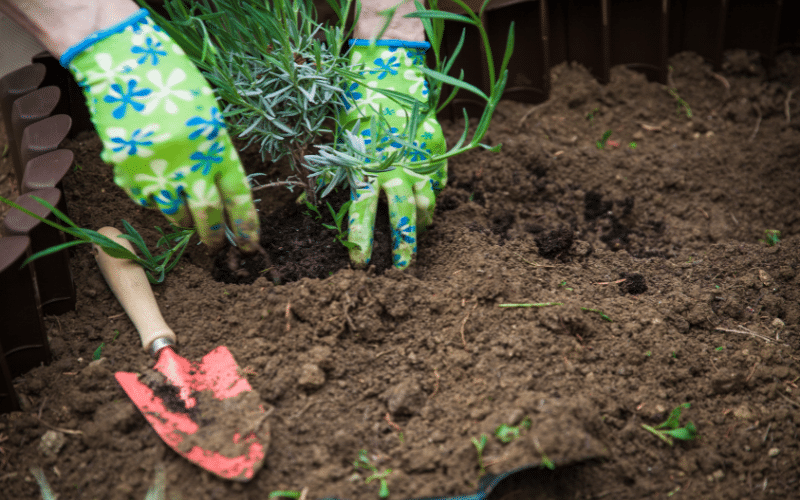
planting
If you’re an avid gardener, most months involve planting the correct species. For instance, February is a great time to plant bare-root trees, artichokes, and shallots. And you typically produce roses in March. To continue expanding your flower bed or vegetable garden, learn what plants you should add according to your area’s growing season and month. Your local Extension Service is a great resource.
mulching
Re-mulching your garden is not something you’ll need to do every month. However, it’s wise to assess the condition of your mulch and consider if it is necessary. You may want to re-mulch for functionality or appearance reasons.
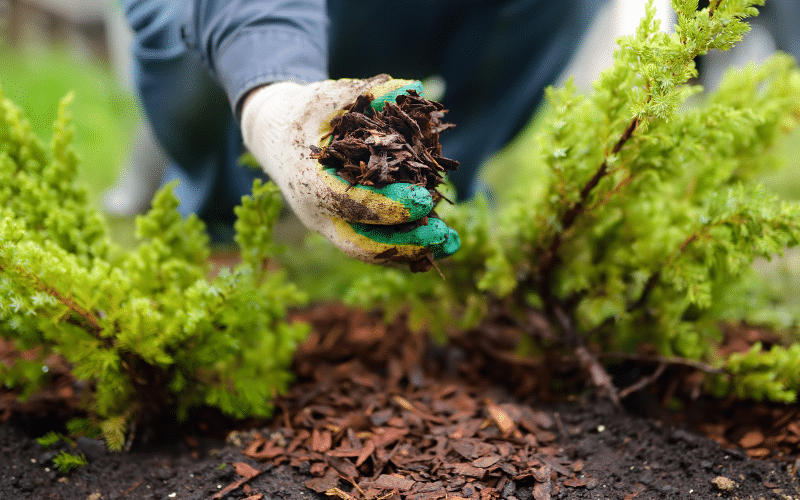
ordering
Finally, you should think ahead every month and order the following month’s bulbs, seeds, and sprouts. Depending on where you get your plants, they may take a little while to get to you. The last thing you want is to be set back because of a mailing issue.
seasonal garden maintenance
Seasonal maintenance is critical to a healthy and flouring home garden! Each quarter of the year brings new weather conditions, different humidity levels, and varying temperatures.
winter
The winter months are slower for gardeners, but there are certainly some things you need to do to keep your plants safe from the chill.
Protect sensitive plants from frost. Bring some inside if you need to. Or you can cover your plants in the evening to keep them warm overnight. Adding extra layers of mulch to insulate the roots is also a great way to beat the winter frost. You may introduce a slow-release fertilizer to some plants this time of year.
There’s far less to do in the winter, so this is also the perfect season to brainstorm your plans for next year’s garden. Set goals and figure out what you need to do to attain them. Similarly, sharpening tools is a good use of the slower gardening months.
spring
In the springtime, your gardening gradually picks up speed! As the temperatures rise, it’s an excellent time to plant various species you’ve been waiting to introduce to your garden. If you use fertilizer, spring is perfect for adding fast-acting fertilizers for some of your plants.
This Fertilization + Pruning log is a handy resource! Spend a little time noting the specific fertilization and pruning needs for your plants and trees to stay on track. I keep it in a plastic sleeve on a cabinet door in my garage and use my sharpie to note when I’ve completed a task. At the end of the season, wipe down the sheet with rubbing alcohol to remove the sharpie, and you are ready for next year.
This free printable is available in the Subscriber Library, which all subscribers can access. You can find your password on every News from the Nest email towards the bottom if you’ve forgotten it. Or, click here to have the two-page Garden Maintenance and Fertilization + Pruning Log sent directly to your email inbox.
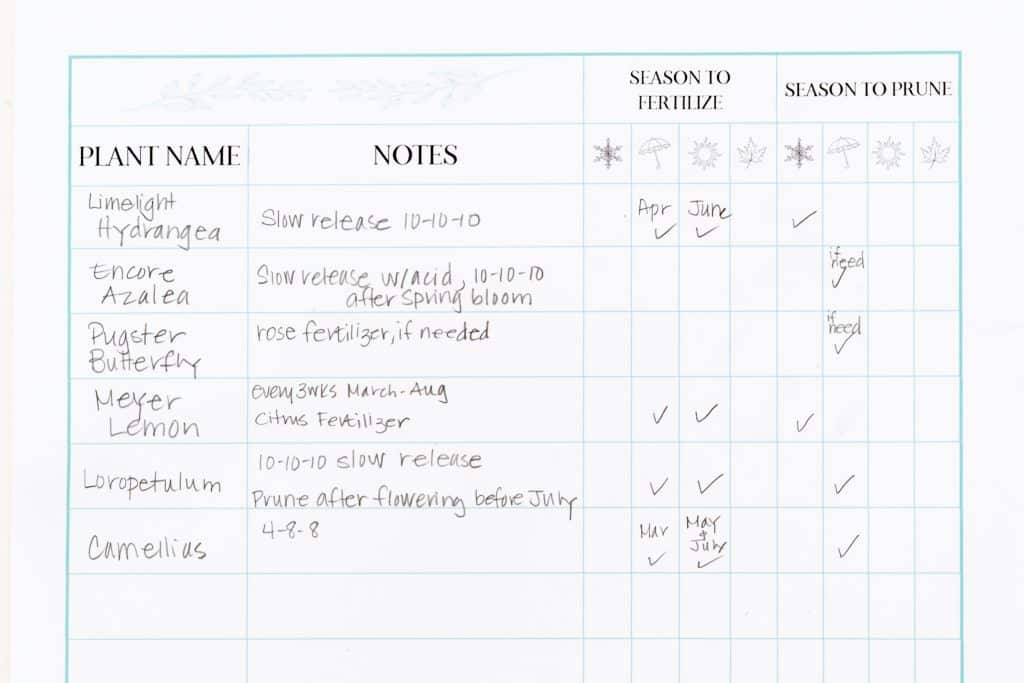
Getting started on your garden pest control is also wise. By the summer, the pests will be plentiful if you don’t get a head start on prevention. Finally, do some extra cleaning up to prepare for the fast-paced end of spring and early summer.
As far as lawn care goes, spring and fall are when you may want to fertilize. If you’re putting in the effort to keep your garden plants healthy, you might as well maintain your entire outdoor space.
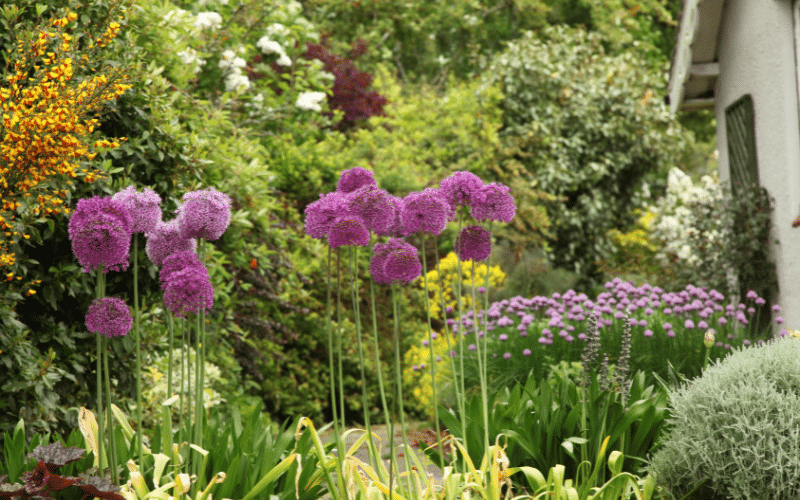
summer
Your plants will grow quickly in the summer, so there’s lots of work to keep up with. It’s an excellent time to spend extra minutes in the garden to prioritize the daily and weekly tasks. With the ideal conditions, it’s easy to fall behind as your garden grows almost too quickly to handle. If you get overwhelmed with this busy season, consider hiring a professional garden maintenance service or neighborhood teen to help catch you up.
Furthermore, some produce may be ready for harvesting in mid to late summer. So, keep an eye out for fresh fruits and veggies!
fall
Fall gardening starts to slow down some as the temperatures drop. Most of the remaining harvest should be ready to pick in early to mid-fall. A little later in the season, depending on where you live, you may want to start bringing more tender plants indoors to prepare for the chilly nights ahead. Also, you may need to rake daily. Many fallen leaves and debris will pile up, attracting pests and disease in your garden.
nab the helpful garden maintenance ‘schedule’ and the pruning & fertilization Log
Once again, this free printable is available in the Subscriber Library, which all subscribers can access. You can find your password on every News from the Nest email towards the bottom if you’ve forgotten it. Or, click here to have the two-page Garden Maintenance and Fertilization + Pruning Log sent directly to your email inbox.
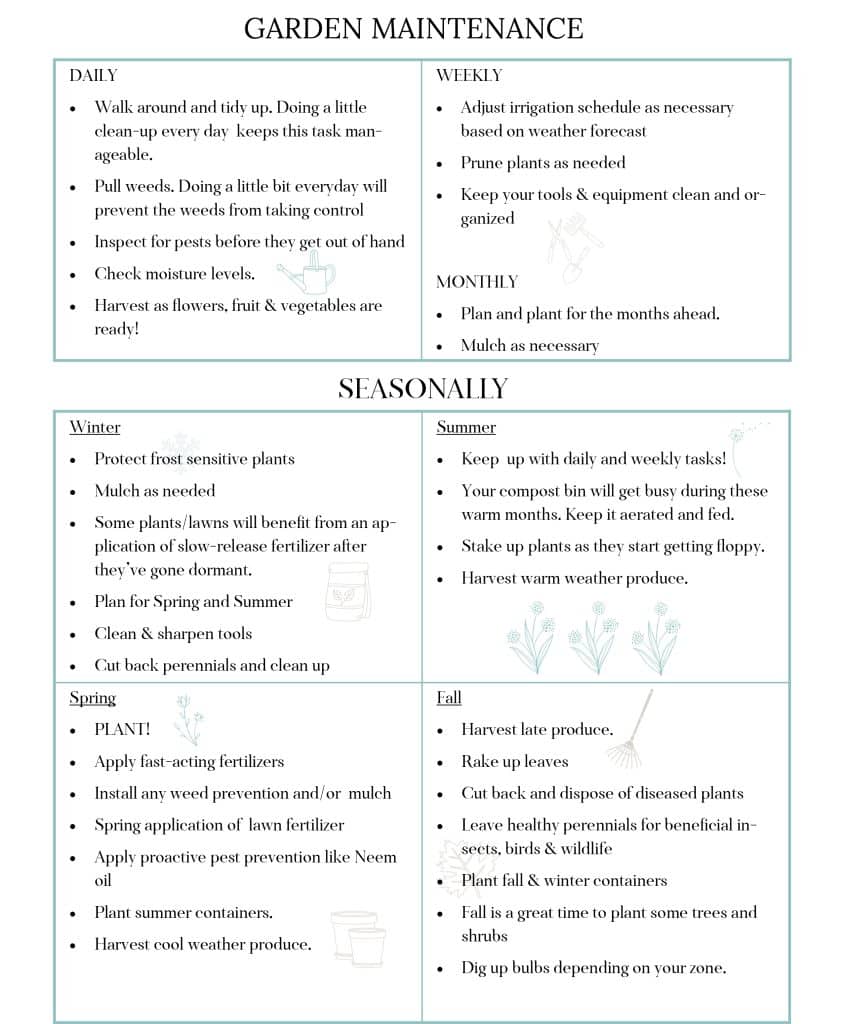

I keep these sheets in a plastic protector on the inside of one of the cabinets in our garage. The garden maintenance schedule is a good reminder of daily, weekly, monthly, and seasonal garden maintenance chores that help you stay on top of your garden.
The pruning & fertilization log is one of those ‘what didn’t I do this earlier’ moments. Take a few minutes to jot down and research the plants in your yard. Note when the best time to prune and fertilize them is and what you should use to fertilize them. We went too long without one of these to guide our garden ‘to-dos.
Keep a sharpie with your sheets and make a dot to indicate what you’ve done for that season. At the end of the year, use rubbing alcohol to wipe the sharpie ink off the plastic so you can reuse it again!
Bookmark this page or pin the following image to refer back to this Garden Maintenance Tips & Printable post in the future.
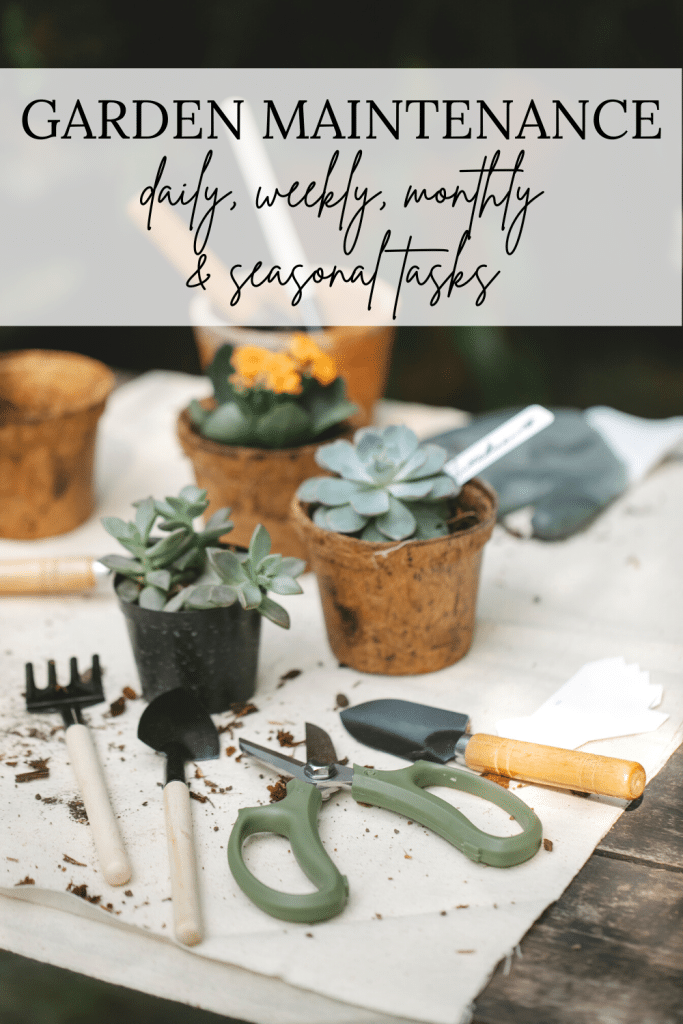
Thanks so much for spending a few minutes of your busy day with me!
To ensure you don’t miss future content, pop your email in the pale green box on the right or click here. I usually send one email weekly, so I won’t inundate your inbox. I’m sensitive to an overflowing email inbox!
We will only use your email address to send you emails, no more than 1-2 weekly. In addition, you will have access to my growing library of knit & crochet patterns and other printables. Check back often as this library will continue to grow. You can unsubscribe anytime by emailing me or clicking on the “unsubscribe” link at the bottom of all emails.
And you can access many of the products I refer to on my Nourish and Nestle Amazon Page. You can access it here.
So, if you’d like to participate in the ‘subscriber benefit’ action, simply subscribe to Nourish and Nestle here or use the form on the right sidebar. It’s slightly towards the top.
I have sent all my subscribers the link to the Subscriber Benefits Library. If you missed it or misplaced it, let me know.
Until next time…


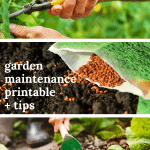

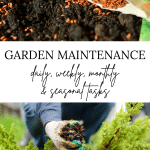
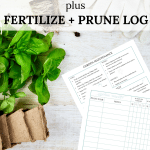
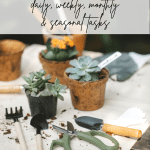
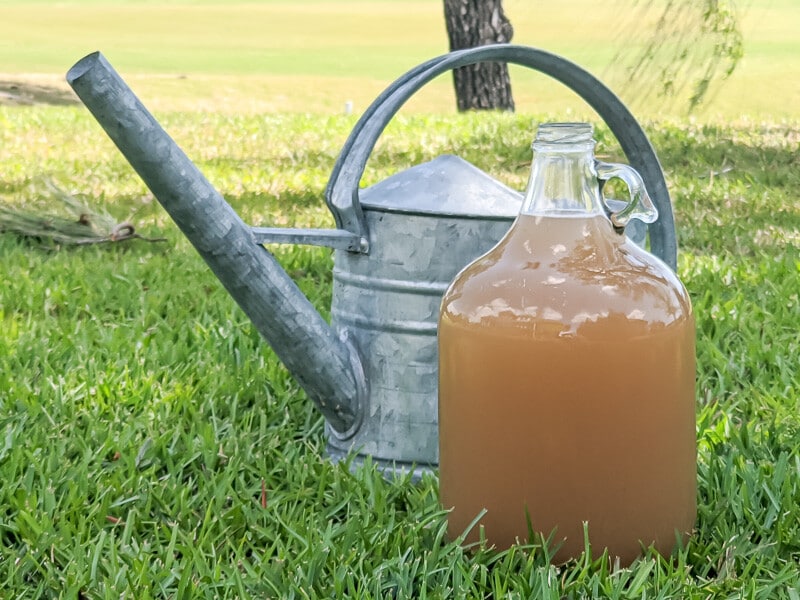
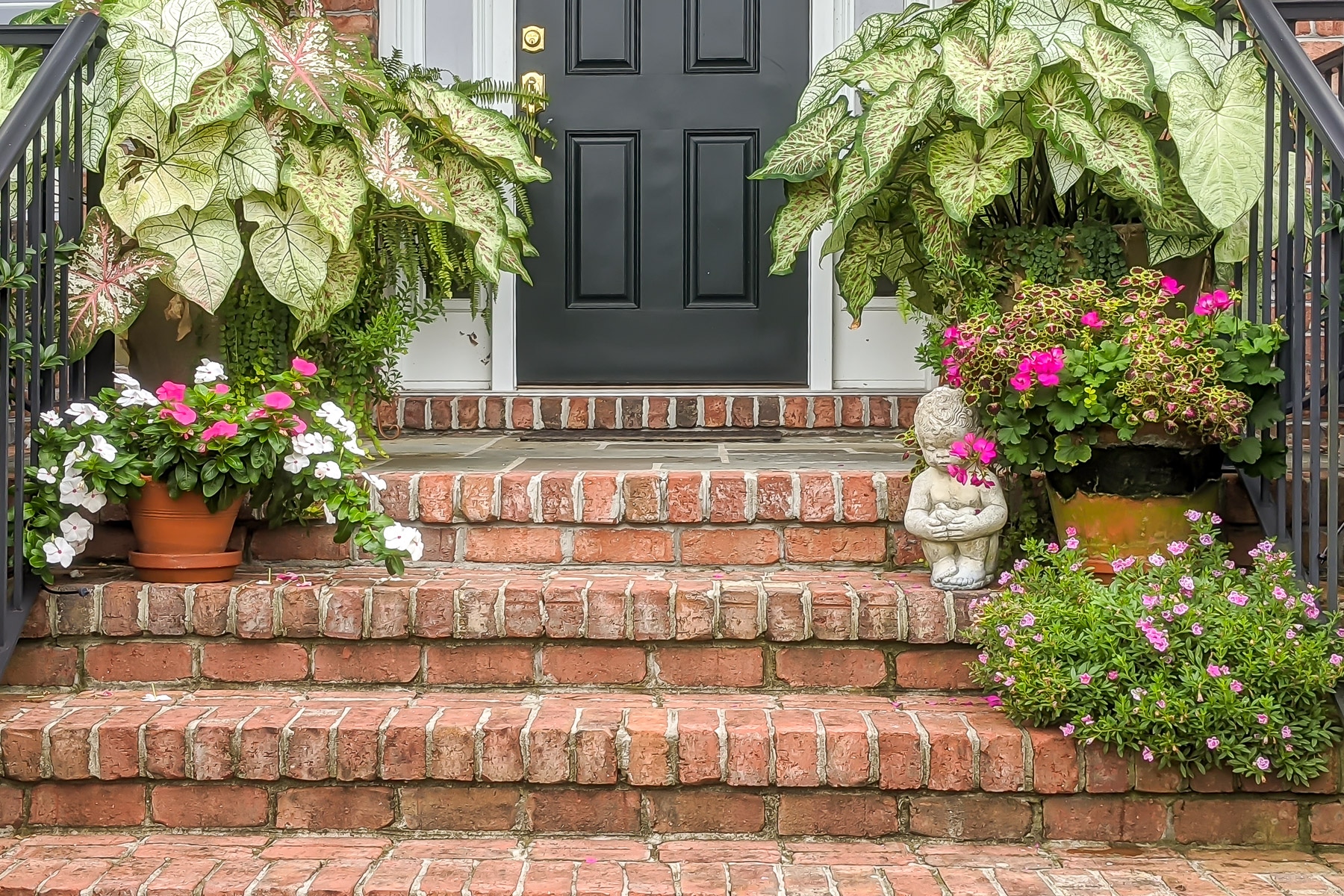
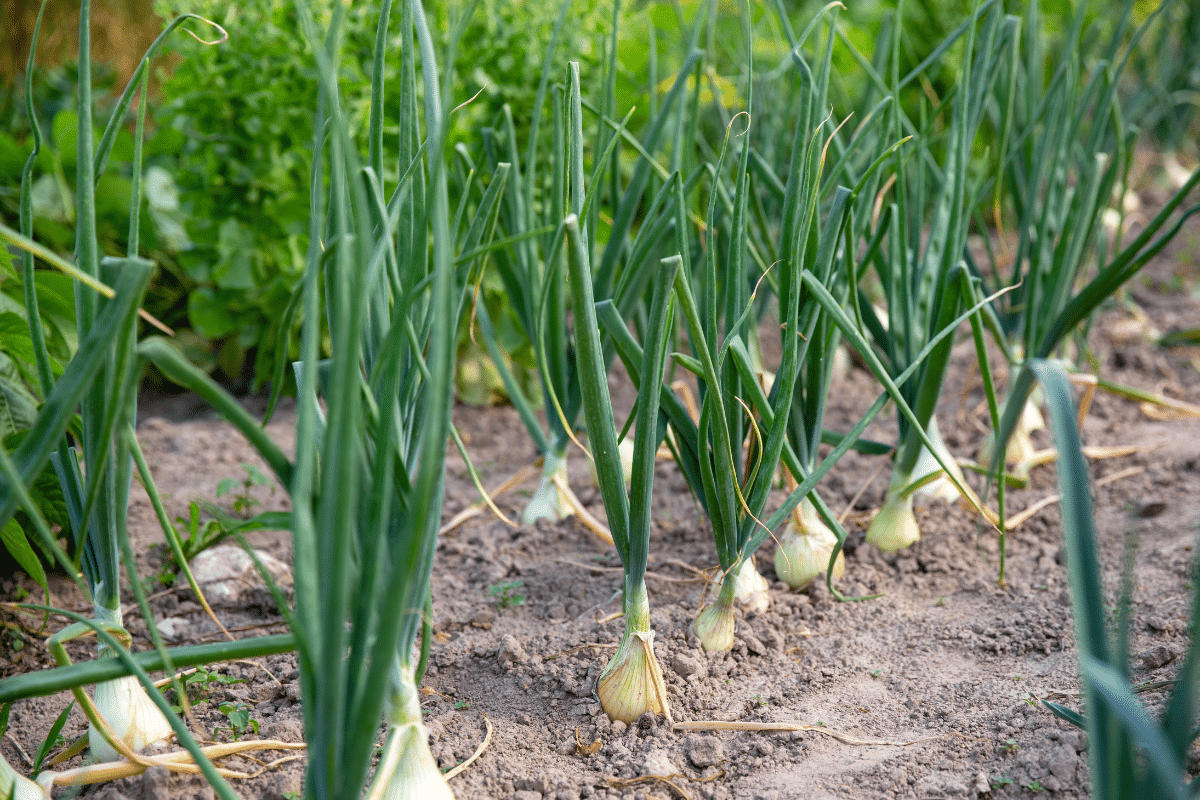
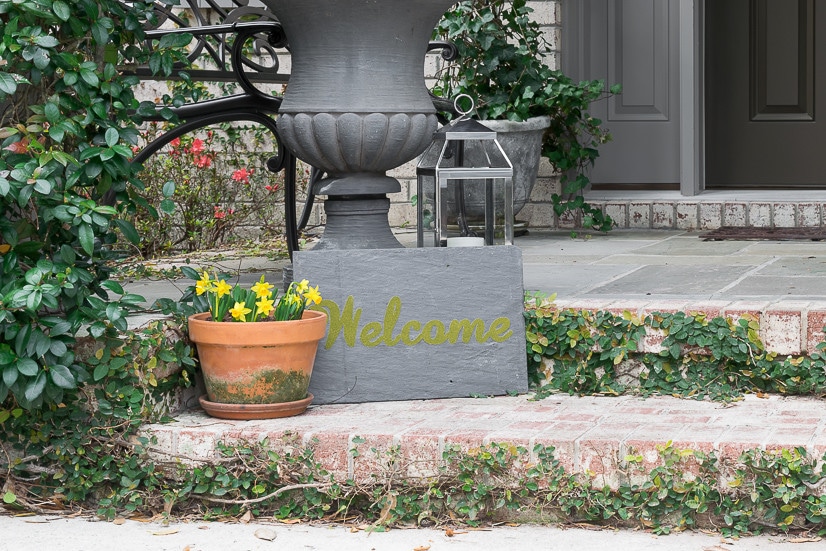

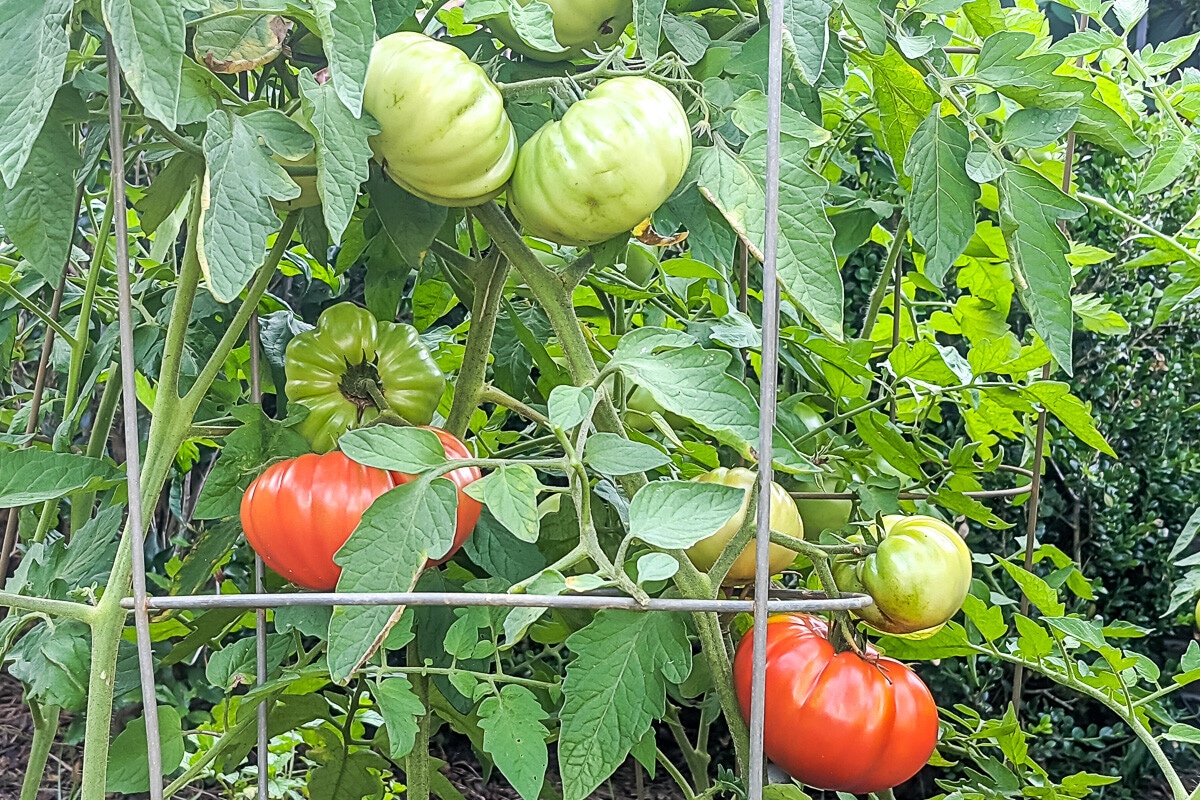
Please do not share my email .
Hi Gigi,
I can 100% promise you that we will never share any subscriber email addresses. I know what it’s like to be on the receiving end of the barrage of emails after I’ve subscribed to something and would never do that to anyone associated with my blog.
I hope you enjoy the printable!
Lynn